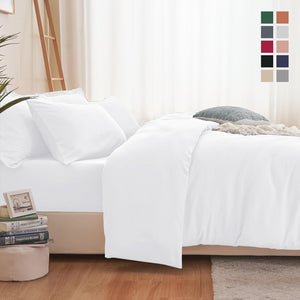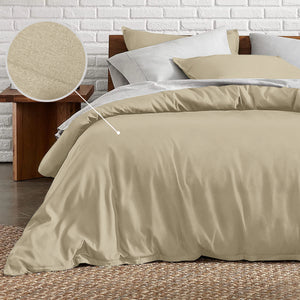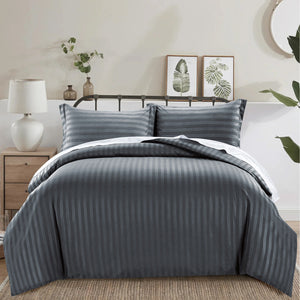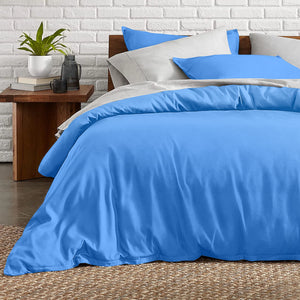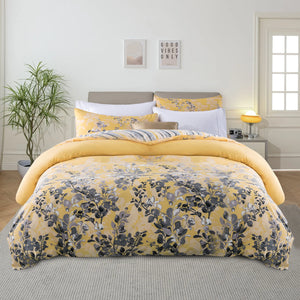What is a Doona Duvet? What Makes a Doona Duvet Unique?
Hello there, and welcome! Today, we're diving into the cosy, cloud-like world of doona duvets. You're not alone if you’ve ever been tangled in bed terminology. The realm of bedding can be surprisingly complex. Whether you're looking to upgrade your sleeping experience or just curious about the fuss, this guide will help you understand what makes a doona duvet unique.
What is a Doona Duvet?
First things first: what exactly is a doona duvet? The term "doona" is commonly used in Australia and is synonymous with what many people worldwide call a "duvet". Essentially, a doona is a blanket filled with insulating material, encased in a fabric cover, and used as a top layer on a bed. The purpose of a doona duvet is to provide warmth and comfort while you sleep. Unlike traditional blankets, duvets are often used with a removable cover, which makes them easier to clean and maintain.
What Materials are Used in Doona Duvets?
Doona duvets can be filled with various materials, each offering different benefits. Let’s explore these options in detail:
Natural Fillings

Down: Down is the soft, fluffy underlayer found beneath the feathers of ducks and geese. It’s renowned for its excellent insulation properties, lightweight feel, and softness. Down doonas are often considered the gold standard in bedding due to their comfort and breathability.
Feather: Feather-filled doonas include the more prominent, more rigid feathers from ducks or geese. While not as soft as down, feathers offer good insulation and are generally more affordable. They tend to be heavier and provide a more substantial feel.
Wool: Wool-filled doonas are perfect for those seeking natural temperature regulation. Wool is breathable and moisture-wicking, and it is excellent at keeping you warm in winter and cool in summer. It's also hypoallergenic and resistant to dust mites.
Synthetic Fillings

Polyester: Polyester fillings are a popular choice for budget-friendly options. These doonas are durable, lightweight, and easy to care for. They are often hypoallergenic, making them suitable for people with allergies.
Microfiber: Microfiber is a finer form of polyester that mimics the softness and warmth of down. It’s lightweight, easy to clean, and typically more affordable than natural fillings. Microfiber doonas offer a good balance of comfort and practicality.
Unique Features of Doona Duvets
Breathability
One of the standout features of doona duvets is their breathability. Natural fillings like down, and wool excel in this area, ensuring you stay comfortable by regulating your body temperature throughout the night. Synthetic fillings also offer good breathability, though they may not match the natural materials.
Insulation Properties
Doona duvets are designed to provide exceptional insulation. Down is mainly known for trapping heat while remaining lightweight. Wool offers insulation with added moisture-wicking properties, making it a great choice for various climates. Synthetic options like microfiber can also provide excellent warmth without the high cost.
Weight and Loft
The weight and loft of a doona duvet significantly impact its comfort level. Down and microfiber fillings are light and lofty, giving a cloud-like feel. Feather-filled doonas are heavier, offering a more substantial presence. Wool doonas strike a balance with moderate weight and loft, combined with their natural benefits.
Durability
Durability is another critical factor. Natural fillings like down and wool tend to be more durable, maintaining their loft and insulation properties for many years with proper care. Synthetic fillings are durable but may lose their loft quicker than high-quality natural fillings.
Benefits of Using a Doona Duvet
Comfort and Warmth
One of the primary benefits of using a doona duvet is the unparalleled comfort and warmth it provides. The combination of soft fillings and insulating properties ensures a cosy sleep environment, whether it’s the chill of winter or the moderate temperatures of other seasons. You may also shop Plain Duvet Covers from Yorkshire Bedding.
Hypoallergenic Options
Hypoallergenic doona duvets are available for those with allergies. Synthetic fillings like polyester and microfiber are typically hypoallergenic, while natural fillings like wool also offer resistance to allergens and dust mites.
Easy Maintenance
Doona duvets are relatively easy to maintain. Most come with removable covers that can be washed regularly. This not only keeps the duvet clean but also extends its lifespan. Synthetic doonas can often be machine-washed, while natural-filled ones might require professional cleaning.
Versatility
Another appealing feature of doona duvets is their versatility. They can be used year-round by changing the cover or opting for different fillings suited to the season, making them a practical choice for any bedroom.
How to Choose the Right Doona Duvet?
Climate Considerations
When choosing a doona duvet, consider the climate you live in. Down and wool are excellent for colder climates due to their superior insulation. In contrast, synthetic fillings like microfiber might suit moderate climates, or those who prefer a lighter cover.
Personal Preferences
Your personal preferences play a significant role. Do you prefer a lightweight, fluffy duvet or something with more weight and substance? Do you have allergies that need to be considered? Answering these questions will help you narrow down your choices. You may also shop Stripe Duvet Covers from Yorkshire Bedding.
Budget Considerations
Budget is always a crucial factor. Natural fillings like down and wool are typically more expensive but offer long-term benefits and durability. Synthetic options provide affordability and practicality but may need to be replaced more frequently.
Comparing Doona Duvets with Other Bedding Options
Doona Duvet vs. Comforter

A doona duvet differs from a comforter in that it usually requires a cover. Comforters are often ready to use straight from the package. Duvets offer the advantage of easy cleaning due to the removable cover, while comforters might need more frequent washing.
Doona Duvet vs. Quilt

Quilts are typically lighter and consist of a single layer of fabric with some light filling, making them suitable for warmer climates or as an additional layer in colder weather. Doona duvets provide more insulation and can be adjusted for different seasons with various covers.
Doona Duvet vs. Blanket

Blankets are generally thinner and used in conjunction with other bedding items. They don’t offer the same level of insulation or comfort as a doona duvet. Duvets can replace multiple layers, simplifying bed-making and providing consistent warmth.
Conclusion
In summary, doona duvets are a versatile, comfortable, and practical bedding. Whether filled with luxurious down, breathable wool, or affordable synthetic materials, a doona duvet suits every preference and budget. They offer superior insulation, breathability, and easy maintenance, making them an excellent investment for a good night’s sleep.
There you have it: a comprehensive guide to doona duvets! I hope you found this information helpful and feel more confident choosing the perfect doona duvet for your needs. Happy sleeping!
FAQs
What is the Difference Between a Doona and a Duvet?
There is no difference; "doona" is used in Australia, while "duvet" is more commonly used worldwide.
How Often Should You Replace a Doona Duvet?
It’s generally recommended to replace your doona duvet every 5 to 10 years, depending on the quality of the filling and how well it’s maintained.
Can You Use a Doona Duvet All Year Round?
Yes, you can use a doona duvet all year round. Choose a lighter filling for summer, a heavier one for winter, or an all-season duvet with adjustable warmth.
What is the Best Filling for a Doona Duvet?
The best filling depends on your needs. Down offers luxury and warmth, wool provides natural temperature regulation, and synthetic fillings like microfiber are hypoallergenic and affordable.
How Do You Properly Clean a Doona Duvet?
Most doona duvets come with care instructions. Natural-filled duvets often require professional cleaning, while synthetic ones can usually be machine-washed. Always follow the manufacturer’s guidelines to maintain the duvet's quality and longevity.





